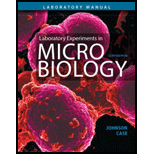
Laboratory Experiments in Microbiology (12th Edition) (What's New in Microbiology)
12th Edition
ISBN: 9780134605203
Author: Ted R. Johnson, Christine L. Case
Publisher: PEARSON
expand_more
expand_more
format_list_bulleted
Concept explainers
Question
Chapter 54, Problem 2Q
Summary Introduction
To write:
The reason for using the heterotrophic plate count preferred for the food instead of other techniques such as direct microscopic and turbidity.
Introduction:
A culture plate:
In biology, it is a low and flat-bottomed laboratory container. It is useful to grow a layer of organisms on a thin nutrient medium layer. These include the molds, bacterias, and other cells. The most ordinary types of culture plates are the multiwell plate and the Petri dish.
Expert Solution & Answer
Want to see the full answer?
Check out a sample textbook solution
Students have asked these similar questions
Why is it critical to be able to determine the overall number of bacteria present in a food sample?
Based on the growth you saw on your Lee’s Agar plate, what conclusions can you make about the bacteria present in the yogurt sample?
what is the physical characteristics of this streak plate? Look at a single colony on a streak plate and look for special physical characteristics such as: motility, possible presence of endospores and/or capsule, culture color?
Chapter 54 Solutions
Laboratory Experiments in Microbiology (12th Edition) (What's New in Microbiology)
Knowledge Booster
Learn more about
Need a deep-dive on the concept behind this application? Look no further. Learn more about this topic, biology and related others by exploring similar questions and additional content below.Similar questions
- What is the correct shape of the unknown bacterium growing on your mannitol salt agar?arrow_forwardWhy are the streak plates incubated at 7°C when selecting for psychrotrophic bacteria?arrow_forwardIn the preparation of a bacterial smear, why is there a need to fix the bacteria to the slide? Aside from passing the slide over a flame, what are the other ways of fixing the bacteria to the slide?arrow_forward
- For the following methods of bacterial enumeration does the method determine total count or viable count? MPN microscopic count Standard plate count Turbidityarrow_forwardWhy do petroleum-degrading bacteria need to attach to thesurface of oil droplets?arrow_forwardA broth culture is initially inoculated with a single bacterial cell. For the first hour the bacteria has a generation time of 30 minutes, for the second hour the generation time has been reduced to 15 minutes, and for the third hour the generation time has been reduced to 10 minutes. At the end of the third hour how many bacteria are present in the broth culture?arrow_forward
- Are the large numbers of microorganisms found in the mouth cause for concern? Explain. How can you determine whether a culture or subculture is pure? What kinds of clinical speciments may yield a mixed flora in bacterial cultures? Why was a blood agar, rather than a nutrient agar, plate used for the culture from your mouth?arrow_forwardwhat type of bacteria may cause spoilage in coconut water that has been in the fridge for more than a week?arrow_forwardFor the following methods of bacterial enumeration, does the method determine total count or viable count?a. MPN b. Microscopic countc. Standard plate countd. Turbidityarrow_forward
- Where/ How did the researchers find the bacterium, which they named Ideonella sakaiensis 201-F6? Apart from applications in recycling plastics and/or fermentation of PET products, why is this considered a remarkable finding?arrow_forwardWhy do cells need to be kept in the freezing devices first then transferred to liquid nitrogen storage in crypto preservation? In addition, why are antibiotics not used in the cell freezing media? Why FBS concentration higher than 10% (10% is the standard concentration in complete growth media) is recommended in cell freezing media?arrow_forwardThe students of a Microbiology class were tasked to transfer or subculture a pure culture of Escherichia coli bacterium in five 7 mL nutrient broth and five petri dishes of nutrient agar with 20 mL capacity each. Based on the instruction bottles for nutrient broth and nutrient agar, preparation of the culture media is as follows. Nutrient broth: 8 g/liter Nutrient agar: 28 g/liter Answer the following: a. What is the weight in grams of nutrient broth? b. What is the weight in grams of nutrient agar? c. What is the distilled water in mL for nutrient broth? d. What is the distilled water in mL for nutrient agar?arrow_forward
arrow_back_ios
SEE MORE QUESTIONS
arrow_forward_ios
Recommended textbooks for you

Bacterial Structure and Functions; Author: Osmosis;https://www.youtube.com/watch?v=b15Hy3jCPDs;License: Standard youtube license